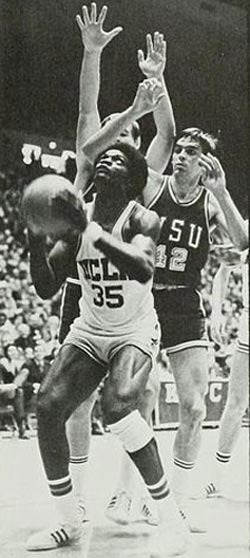NBA Season Recaps: 1971-1972 Season
By Lorenzo Tanos
The 1970s were known as a decade where many a team had a chance to win an NBA title, but no dynasty, much less one on the level of the Boston Celtics', dominated the league. The Lakers, despite their then-NBA record 69-13 standing and 33-game winning streak (still a record), were a team that was quickly aging, with Jerry West and Wilt Chamberlain 33 and 35 respectively, and Elgin Baylor 37 years old and only available for nine games off the bench.
The Milwaukee Bucks didn't have a capable replacement on hand for Oscar Robertson, while the New York Knicks didn't get much return yet from their acquisition of Earl Monroe from the Baltimore Bullets.
Meanwhile, the Boston Celtics had a fairly young core group of John Havlicek, Jo Jo White and Dave Cowens, and were back in championship contention.
Still, none of that was enough to stop the Lakers, who went 12-3 in the Playoffs to win their first championship since the George Mikan days.
|
|
NBA Champions – Los Angeles Lakers (d. New York Knicks, 4-1)
MVP – Kareem Abdul-Jabbar (Milwaukee Bucks, 34.8 ppg, 16.6 rpg, 4.6 apg)
Rookie of the Year – Sidney Wicks (Portland Trail Blazers, 24.5ppg, 11.5 rpg, 4.3 apg)
LEAGUE LEADERS
– Kareem Abdul-Jabbar (Milwaukee Bucks, 34.8 ppg), Wilt Chamberlain
(Los Angeles Lakers, 19.2 rpg), Jerry West (Los Angeles Lakers, 9.7
apg), Wilt Chamberlain (Los Angeles Lakers, 64.9% FG), Jack Marin
(Baltimore Bullets, 89.4% FT), Dave Cowens (Boston Celtics,314 fouls)
THE ULTIMATE TEAM PLAYER
– After so many seasons of ruling over the scoring parade, Wilt
Chamberlain became the ultimate team player for the Los Angeles Lakers,
averaging a career-low 14.8 ppg on less than ten field goal attempts per
game. Still, he averaged 19.2 ppg and 4.0 apg and shot 64.9% from the
field…but just 42.2% from the line, which was, at least presentable
compared to his 38.0% free throw clip from 1967-68
|
AN UNLIKELY DIVISION CHAMP
– The Baltimore Bullets topped the Central Division despite finishing
with a 38-44 record and losing Earl Monroe to the New York Knicks after
just three games. Their top scorer at this point, with Gus Johnson on
his way to retirement and Wes Unseld focusing solely on rebounding and
defense, was not Jack Marin, but Archie Clark (25.1 ppg, 8.0 apg), he of
the Chamberlain-for-Clark, Imhoff and Chambers trade. Marin would
finish second in scoring with 22.3 ppg, while Unseld averaged 13.0 ppg,
17.6 rpg and 3.7 apg, his outlet passing wizardry finally translating to
high numbers for a center. |
UCLA basketball player Sidney Wicks.
|
A LOOK AT THE LEAGUE LEADERS/TITLE WINNERS – As mentioned above, Wilt Chamberlain became gun-shy as an older player, instead focusing on rebounding and defense. But it was all for the best, as the Lakers did set an all-time best win-loss record that would stand for over two decades. The record-setting Lakers got the most offense from the dynamite backcourt tandem of Jerry West (25.8 ppg, 9.7 apg) and Gail Goodrich (25.9 ppg, 4.5 apg), while Jim McMillian (18.8 ppg, 6.5 rpg) and Happy Hairston (13.1 ppg, 13.1 rpg) were both solid in the corner spots. If the Lakers did have one weakness on that 69-13 team, it was the bench, which was led by offense guy Flynn Robinson (9.9 ppg).
A LOOK AT THE CELLAR DWELLERS – The Portland Trail Blazers, in their second year in the NBA, took a step backwards in terms of overall record, but they did have two good young players to build on – 1971-72 Rookie of the Year Sidney Wicks (24.5 ppg, 11.5 rpg, 4.3 apg) and 1970-71 co-Rookie of the Year Geoff Petrie (18.9 ppg, 4.1 apg). Apart from those two, the Blazers were painfully weak compared to the rest of the league – the other starting spots were filled by career backup Dale Schlueter at center, minor draft flop Gary Gregor at small forward, and future NBA head coach Rick Adelman at point guard.
Other notable 1971-72 Blazers included Larry Steele, who would enjoy a decent career as a defensive specialist at guard and forward, and DarrallImhoff, who is best known as the man who defended Wilt Chamberlain in his 100-point game, as well as the player selected right behind Oscar Robertson and Jerry West in the 1960 Draft.
What do you think?
We'd love to hear your comments and/or opinions. If you submit them here, other visitors can read them, rate them and comment on them. An e-mail address is not required.
From NBA Season Recaps: 1971-1972 Season to NBA Basketball Blog | Sports Blog | NFL Football Blog | NCAA Football Blog | NFL Football Archives | College Football Archives | Current Sports Scores | NCAA Basketball Blog | WNBA Basketball Blog | NBA Basketball Archives | NCAA Basketball Archives | Current Sports Scores | MLB Baseball Blog | College Baseball Blog | MLB Baseball Archives | Fantasy Football | Fantasy Basketball | Fantasy Baseball | The Best Sportswriter Contest | Sports Trivia Questions | Other Sports | Soccer Archives | Olympics Archives | Stupid Athletes Archives | Other Archives | Sports Basics | Top Sports Blogs | Best Sports Pictures | The Best Sports Videos | Best Current Sports News | The Best Sports Blog Podcasts | Football Forum | Basketball Forum | Baseball Forum | NFL Football Store | NBA Basketball Store | MLB Baseball Store | NCAA Football Store | NCAA Basketball Store | NCAA Baseball Store | Fatheads | NFL Football Tickets | NBA Basketball Tickets | MLB Baseball Tickets | NCAA Football Tickets | NCAA Basketball Tickets | NCAA Baseball Tickets | Sports Kindle E-Books | Best Sports Blog Books |
About Us | Contact Us | Site Search | Advertise | Terms of Use |







New! Facebook Comments
Leave a comment about this article in the box below and share it with your Facebook friends.